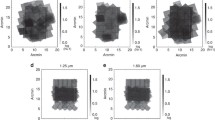Abstract
Amplitude distributions, which are nearly Gaussian, have been calculated for radial velocity, continuum brightness, spectral line equivalent width and spectral line central residual intensity fluctuations measured from high-dispersion high-resolution spectrograms taken at the center of the solar disk. The RMS and skewness S for each distribution have been calculated in a manner which allows testing of the homogeneity of the granulation pattern (i.e. variations in its statistics across the solar disk and with time). Pattern inhomogeneity across the disk is strongly indicated, and further evidence suggesting appreciable pattern persistence over time intervals ≳ 15 minutes is presented. The possibilities for investigations of S and its associated bi-spectrum are discussed. The qualitative values of S obtained are shown not to be due to unusually bright, rising granules (though a statistical tendency towards such granules is possible). An attempt to explain S for continuum brightness fluctuations in terms of the nonlinear effects of Planckian emission and opacity fluctuations in a stratified photosphere, leads to contradiction with the measured amplitude distributions, a contradiction which is probably due to an oversimplified treatment of radiative transfer in an inhomogeneous photosphere.
Similar content being viewed by others
References
Bahng, J. and Schwarzschild, M.: 1961a, Astrophys. J. 134, 312.
Bahng, J. and Schwarzschild, M.: 1961b, Astrophys. J. 134, 337.
Bernière, G., Michard, R., and Rigal, G.: 1962, Ann. Astrophys. 25, 279.
Edmonds, F. N., Jr.: 1962a, Astrophys. J. Suppl. 6, 357 (No. 60).
Edmonds, F. N., Jr.: 1962b, Astrophys. J. 136, 507.
Edmonds, F. N., Jr.: 1964, Astrophys. J. 139, 1358.
Edmonds, F. N., Jr.: 1966, Astrophys. J. 144, 733.
Edmonds, F. N., Jr., Michard, R., and Servajean, R.: 1965, Ann. Astrophys. 28, 534.
Edmonds, F. N., Jr. and McCoullough, R. J.: 1966, Astrophys. J. 144, 754.
Hasselmann, K., Munk, W., and MacDonald, G.: 1963, Time Series Analysis, Series in Applied Mathematics (ed. by M. Rosenblatt). John Wiley, New York, Chapter 8.
Pierce, A. K. and Waddell, J. H.: 1961, Mem. Roy. Astron. Soc. 68, 89.
Richardson, R. S. and Schwarzschild, M.: 1950, Astrophys. J. 111, 351.
Rösch, J.: 1963, private conversation.
Rybicki, G. B.: 1965, Smithsonian Astrophys. Obs. Special Report No. 180.
Schlesinger, F.: 1938, Astron. J. 46, 161.
Schwarzschild, M.: 1959, Astrophys. J. 130, 345.
Trumpler, R. J. and Weaver, H. F.: 1953, Statistical Astronomy. University of California Press Berkeley; reprinted 1962 by Dover Publications, New York.
Author information
Authors and Affiliations
Rights and permissions
About this article
Cite this article
Edmonds, F.N. Amplitude distributions of solar photospheric fluctuations. Sol Phys 1, 5–15 (1967). https://doi.org/10.1007/BF00150300
Received:
Issue Date:
DOI: https://doi.org/10.1007/BF00150300




